ISSN ONLINE(2320-9801) PRINT (2320-9798)
ISSN ONLINE(2320-9801) PRINT (2320-9798)
Arunkumar1, G.G. Sivasankari2
|
| Related article at Pubmed, Scholar Google |
Visit for more related articles at International Journal of Innovative Research in Computer and Communication Engineering
Near Field Communication (NFC) is a set of standards for smart phones and similar devices to establish radio communication with each other by touching them together or bringing them into close proximity, within few inches. Present and anticipated applications include contactless transactions, data exchange, and simplified setup of more complex communications such as Wi-Fi. The NFC is a promising technology for Internet of Things (IoT), refers to uniquely identifiable objects and their virtual representations in an Internet-like structure. In this paper, we propose a system to control electronics appliances through NFC using Internet of Things.
Keywords |
| IoT, NFC, NFC enabled devices, NFC tags, ZigBee |
INTRODUCTION |
| The NFC technology is simple. It's a short-range, low power wireless link evolved from radio-frequency identification (RFID) technology that can transfer small amounts of data between two devices held a few centimetres from each other. Unlike Bluetooth, no pairing code is needed, and because it's very low power, no battery in the device being read. By tapping your phone on a contactless payment terminal in a shop, train station or coffee shop is able to identify your account (and even personal preferences, shopping habits) and takes payment through an application on phone. Passive NFC 'tags' on posters, in shops and on trains could contain a web address, a discount voucher, a map or a bus time table that passers-by could touch their phones on to receive – or to instantly pay for absolutely anything. |
| Acting as a secure gateway to the connected world, tomorrow’s NFC-enabled mobile devices will allow consumers to store and access all kinds of personal data – at home or on the move. Simply by bringing two NFC-enabled devices close together, they automatically initiate network communications without requiring the user to configure the setup. The electronic device can be controlled through the Android mobile by using NFC technology. The user has to show the Android mobile phone which is NFC enabled to the NFC tag. The NFC facilitates us to read or write the NFC tags. So user can define his tags according to his requirement. |
A. NFC Framework |
| A NFC device can communicate with both existing ISO 14443 smartcards and readers, as well as with other NFC devices, and is thereby compatible with contactless infrastructure already in use for public transportation and payment. NFC device can be utilized for peer-to-peer message exchanges, simply by bringing the devices close together. A protocol automatically enables this peer-to-peer communication. Figure 1 shows a NFC reference implementation framework. |
| The NFC chip embedded in the mobile device reads the information in the tag, thus emulating a smart card, so that the reader can access its data, or can communicates directly with another NFC device. Obviously, NFC technology combines two paradigms, the one being communication between devices, where both have active power supply and computing capabilities, and the other being communication between powered devices and passive tags. Such a mechanism is necessary for many applications, e.g., file transfer, authentication and authorization, smart poster, and control context. |
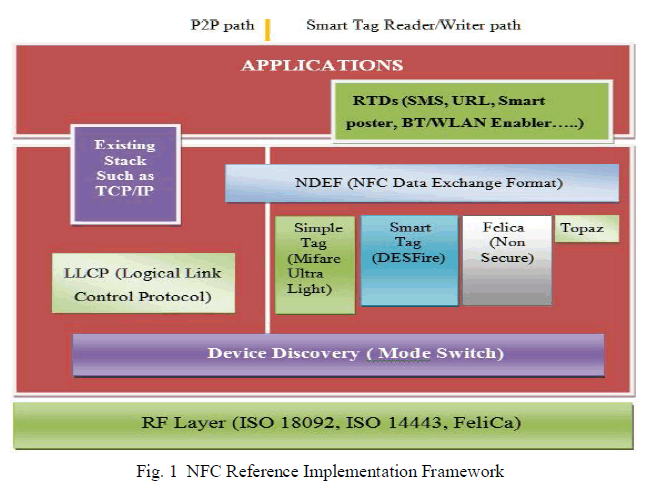 |
| Some NFC phone manufacturers have provided a proprietary Java 2 Micro Edition (J2ME) API for developing mobile applications that make use of NFC capabilities. Siemens has a NFC Service Platform [10] and Nokia a NFC and RFID API [11] to allow the development of such applications. The NFC forum has defined certain specifications for message exchange, such as NFC Data Exchange Format (NDEF), NFC Record Type Definition (RTD), and Type 1/2/3/4 Tag Operation Specification. The NFC Data Exchange Format (NDEF) specification has defined a message encapsulation format for exchanging information, e.g., between one NFC Forum Device and another, or an NFC Forum Tag. NDEF is a lightweight, binary message form that can be used to encapsulate one or more application-defined payloads of arbitrary type and size into a single message construct. Each payload is described by type, length, and optional identifier. In addition, the NFC forum also defines certain Record Type Definitions (RTD) that are intended to support NFC-specific applications and service frameworks by providing a means for reserving well-known record types, and third party extension types. Figure 2 shows the structure of the Generic Control Record Type Definition (GCRTD) [12], while Figure 3 showing an example of message format. Based on GCRTD, the control context of a smart space can be easily exchanged between an NFC phone and reader. |
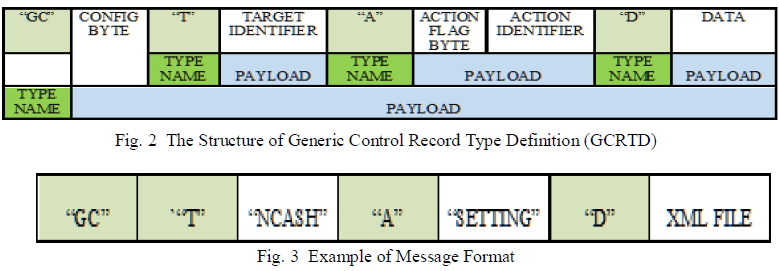 |
| Among the wireless communication technologies that have been developed for use in the home automation environment is Bluetooth, ZigBee [13]. Table 1.1 shows simple comparison between such technologies, concentrating on four main aspects: security, personalization, flexibility, and power consumption. The flexibility in the comparison mainly concerns the question of replacing the control context, which the RFID user will find is not easy. |
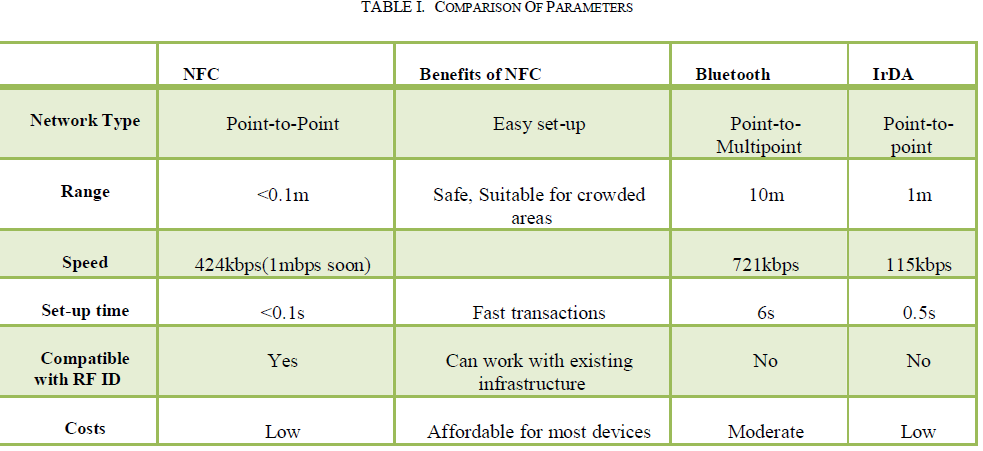 |
B. Operating Modes of NFC |
| NFC is a proximity coupling technology closely linked to the standard of proximity smart cards as specified in ISO 14443. NFC Devices are capable of three different operating modes: |
| 1) Peer-To-Peer Mode |
| This mode is the classic NFC mode, allowing data connection for up to 424kb/sec. The electromagnetic properties and the protocol (NFCIP-1) are standardized in ISO 18092 and ECMA 320/340. |
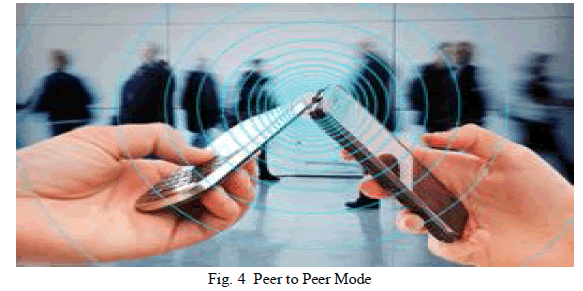 |
2) Reader/Writer Mode (PCD) |
| NFC devices can be used as a reader/writer for tags and smart cards. In this case the NFC device acts as an initiator and the passive tag is the target. In reader/writer mode data rates of 106 Kbits/sec are possible. Proximity coupling device: It is a transmitter that can read tags based on ISO14443 (PICC). The reader emits an electromagnetic field that powers a tag/transmitter by inductivity. It communicates with PICC using load modulation scheme. |
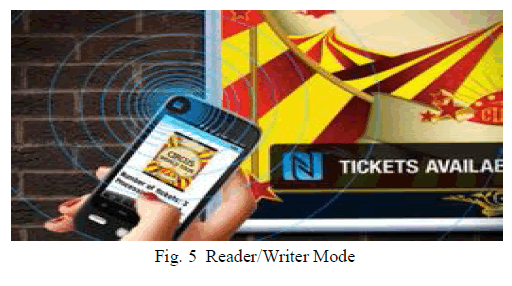 |
3) Tag Emulation Mode (PICC) |
| In this mode the NFC device emulates an ISO 14443 smart card or a smart card chip integrated in the mobile devices is connected to the antenna of the NFC module. A legacy reader can’t distinguish a mobile phone operating in tag emulation mode from an ordinary smart card. |
| Proximity inductive coupling card: a transponder that can be read or written by a proximity reader. Theses tags are based on the ISO14443 standard. Such tags do not have a power supply like a battery, but are powered by the electromagnetic field of the reader (PCD). |
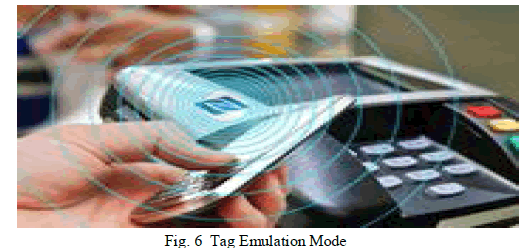 |
| An example of message exchange is shown in Figure 7 ‘‘AU’’ in ‘‘Service Type’’ means that the message has to do with checking authentication. ‘‘Application Name’’ field identifies the name of the application to which the request is addressed. ‘‘Decision Code’’ can be used for various applications, but here carries the requested gate ID. ‘‘Content’’ field can be used to deliver the content of the request. Here, the value ‘‘FFFFFFFFFFFFFFF’’ means that it is a request message for authentication, while the other refers to the content of a tag. |
| The example shown in Figure 7 is that of a user wishing entry to a residential building, where the NFC reader at the main entrance asks for the authentication key. When the NFC phone receives that request, it extracts Decision Code so as to ascertain the relevant authentication code, which it then packed into a tag before finally responding to the tag in the NFC reader. |
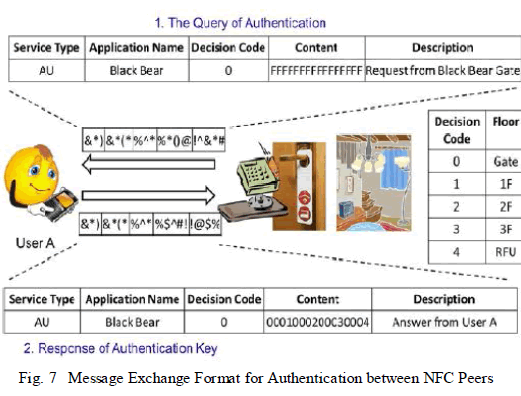 |
RELATED WORK |
| Kim and Lee [1] proposed a personal context-aware Universal Remote Controller (URC), a system that allows users connected to it to control home appliances in their own preferred manner. It is runs via a home server, which supports service discovery and user repositories and allows access to any public universal remote controller. Although personalized control is supported, it is not user-friendly control, seen in the fact that appliances in question require complex interaction, quite unlike one-touch NFC. Han et al. [2] proposed remote-controllable and energy saving room architecture with an automatic standby power cut off outlet and the ZigBee controller with IR (Infrared radiation) codelearning functionality to configure the architecture. The outlet monitors power consumption periodically, with the effect that when the power reads below threshold, it is automatically cut off at the outlet, thus reducing wastage during standby. What this system lacks, though, is sufficient consideration of personalization in the digital or smart home environment. |
| Park et al. [3] proposed a dynamic control scheme for multiple legacy IR-controllable consumer electronic devices based on IEEE 802.15.4, especially on ZigBee protocol. Their scheme uses a URC unit based on ZigBee WPAN, termed Z-URC (ZigBee-based universal remote control), and a ‘‘Z2IR (ZigBee to infrared)’’ conversion module for converting control messages transferred through the ZigBee network into IR typed control signals. The list of devices to be controlled here by the Z-URC dynamically varies, that is, they are added or dropped depending on the location of the Z-URC unit carried by the user from place to place. A further disadvantage is that personalization for the smart environment has not been considered. Nichols and Myers [4] proposed a framework for automatically generating appliance interfaces from abstract specifications of appliance functions. The interfaces here give users full control of appliance functionality and are consistent with any other interface the phone has, which allows leverage of existing knowledge. Although supporting personalized control, their system does have problems with connection cost and security. |
| Other approaches focus on extending user modalities by augmenting interaction methods. Bolt et al. introduced voice and gesture interactions at the graphics interface for a concerted, natural user modality [8]. The problem is that voice and gesture recognition tends to be inaccurate due to environmental noise and algorithm incapability. In the HBCI (Human Build Computer Interaction) system, Hsu et al. use QR codes to identify objects in the room [9]. QR codes are physically compact, easy to deploy, and can be accurately recognized. However, QR code scanning draws user attention heavily to the camera view, and may fail in dark environments. In contrast, NFC based solution uses touch interaction to read information from tags, resulting in fast, intuitive and convenient interaction experience. |
PROPOSED METHODOLOGY |
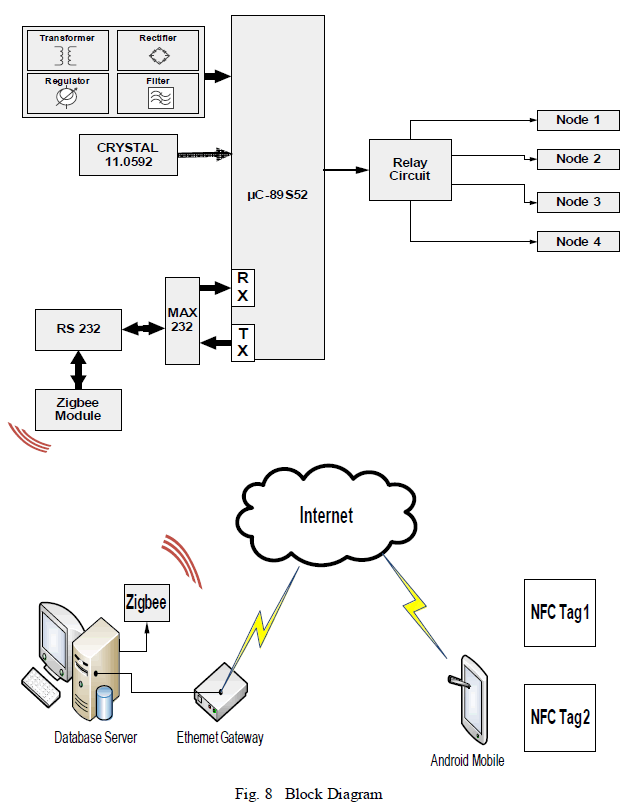 |
| The working principle of this paper is based on the easy read and writes capabilities of NFC TAGS. The different information on different NFC tags can be stored by simply programming or writing them. Now when the user touches any NFC Tag with a NFC enabled phone it will be read easily by the phone. Now the phone can transmit a coded signal to a control system using the Internet transmission channel. The PC at the other end will transfer to controller circuit which will receive the data with the help of ZigBee transmission. The microcontroller control unit will be connected to different loads of home or office or whatever the place you want to atomize. The person who is having the NFC tag which is allowed access can only control the appliances. Once the NFC tag comes in contact with the NFC enabled mobile phone, the information from the NFC tag will be send to the remote system using web. The controller will read the information of the NFC tags sent through internet and analyze which command is to be executed. Thus with the help of just a touch of NFC cards it will control the different loads accordingly. The related modules are explained below. |
| ZigBee Module: is a specification for a suite of high level communication protocols used to create personal area networks built from small, low-power digital radios. ZigBee is based on an IEEE 802.15 standard. Though lowpowered, ZigBee devices often transmit data over longer distances by passing data through intermediate devices to reach more distant ones, creating a mesh network; i.e., a network with no centralized control or high-power transmitter/receiver able to reach all of the networked devices. The decentralized nature of such wireless adhoc networks make them suitable for applications where a central node can't be relied upon. ZigBee is used in applications that require a low data rate, long battery life, and secure networking. ZigBee has a defined rate of 250 Kbit/s, best suited for periodic or intermittent data or a single signal transmission from a sensor or input device. Applications include wireless light switches, electrical meters with in-home-displays, traffic management systems etc. |
| RS-232: is the traditional name for a series of standards for serial binary single-ended data (Single-ended signaling is the simplest and most commonly used method of transmitting electrical signals over wires.) One wire carries a varying voltage that represents the signal, while the other wire is connected to a reference voltage, usually ground.) and control signals connecting between DTE (data terminal equipment) and DCE (data circuitterminating equipment, originally defined as data communication equipment). It is commonly used in computer serial ports. The standard defines the electrical characteristics and timing of signals, the meaning of signals, and the physical size and pinout of connectors. |
| MAX-232: serial port to signals suitable for use in TTL compatible digital logic circuits. The MAX232 is a dual driver/receiver and typically converts the RX, TX, CTS (Clear To Send) and RTS (Request To Send) signals. |
CONCLUSION |
| NFC technology will become omnipresent in our lives. Many devices around us will implement the standards, from the mobile phone to the access management system of our office. Payments, access, sites visited,—all this information can be acquired by monitoring an NFC device that is associated with our identity. Integration of NFC technology with mobile phones which consists of mobility, relatively high processing power, Internet access ability etc. has a great potential to bring new opportunities to our lives. |
| Touch-driven approach is relatively accurate in inferring user intent. Finally, the usability of touch-driven interaction using NFC is better than QR code-based or voice-based interactions, since the touch action is intuitive, and can be detected quickly, requiring no pre-configuration or setup. In this way once the devices are linked up using NFC and IoT, they can exchange information using wireless protocols such as wifi and GPRS remotely. In future work we can include sms gateway to notify the user about the status of the nodes to be monitored. |
References |
|